Written by Tringi Studies
Introduction
EPT Index uses pollution tolerance levels of different macroinvertebrates to indicate water quality. It is named after the three orders of macroinvertebrates that are assessed: Ephemeroptera (mayflies), Plecoptera (stoneflies), and Trichoptera (caddisflies).
Biodiversity is not just another factor — it is just as vital to life on Earth as cultural diversity. These two forms of diversity are interconnected , and the future we aim to build depends on our collective ability to protect both. Biodiversity refers to the variety among living organisms inhabiting terrestrial , marine , and other aquatic ecosystems , including the ecological complexes of which they are a part. It includes diversity within species and between species and ecosystems.
Today, biodiversity represents one of the most pressing global issues. Human activities — such as rapid population growth, widespread deforestation, wetland drainage, industrial expansion, global warming, and acid rain — have altered the diversity of life on our planet more than any other period in human history. Every living being has the right to exist, just like humans. Species that have evolved over millions of years can disappear quickly, yet cannot be recreated.
In this sense, the term “biological diversity” is synonymous with “life on Earth.” Greater biodiversity often means cleaner water and reduced pollution. It enhances water quality and helps ecosystems withstand pollution-related pressures. Each species, no matter how small, plays a vital role in boosting ecosystem productivity.
Among living creatures, insects are the most diverse and are essential to the proper functioning of all ecosystems. However, their numbers are declining due to intensive agriculture, heavy pesticide use, urbanization, and climate change. If this food source disappears, many animals — such as birds, reptiles, amphibians, and fish — will also be at risk of extinction.
Aquatic insects , as part of overall biodiversity, are key subjects in ecological research and environmental monitoring. They serve as indicators of river and stream health. Some species require high levels of dissolved oxygen (found in clean, healthy streams), while others thrive in lower oxygen levels (often found in polluted waters). By analyzing which insects are present in an ecosystem, we can assess oxygen levels — and thus, the health of the system itself.
These organisms are crucial contributors to energy cycles and nutrient processing, including nutrient retention, transfer to terrestrial ecosystems, and water purification.
Research Objective
The aim of this study was to analyze the composition of insect groups (EPT) in the source area of the Erenik River and Lake Radoniq.
- To investigate the diversity of the orders Ephemeroptera , Plecoptera , and Trichoptera (EPT);
- To record the conservation status of selected rare species
- To assess the impact of anthropogenic factors
Insect Fauna
The central location of Kosovo in the Balkan Peninsula, along with its hydrographic, hydrological, and climatic characteristics, has contributed to the country having a very specific fauna. The knowledge of aquatic insect fauna in the Republic of Kosovo is limited.
So far, only the fauna of Plecoptera has been relatively well studied, while other groups are less known and have mostly been researched only in the larval stage as part of the assessment of the quality of running waters, such as the Trichoptera fauna. The presence of insects serves as an ecological indicator of good water quality, and they are an important food source for fish and other aquatic animals.
They are also key contributors to energy flow and nutrient processing, including nutrient capture, returning them to terrestrial ecosystems, and water purification. Therefore, given all the roles they play, it is important to have knowledge about them.
Trichoptera
Trichoptera make up the most diverse order of insects, whose members are exclusively aquatic. The concentration of oxygen, along with the water’s flow rate, is important for their larvae, as is the chemical composition of the water. In fact, certain species have been used as biotic indicators of pollution. Although most larvae feed on aquatic plants, algae, diatoms, or plant debris, some are predators of other aquatic insects, crustaceans, and mollusks.
The larval stages are found in lakes, streams, and rivers across the world and are important components of food webs in these freshwater ecosystems, living for one or more years. The larvae play an important role in the aquatic community by reducing plant growth and decomposing animal and plant waste. Their dominance in macrozoobenthic communities is related to their ability to spin silk nets. They use the silk to build protective cases, which provide shelter from predators, aid in respiration, and, for those that spin nets, help collect food. During the pupal stage, the silk also provides protection during metamorphosis.
Unlike the larvae, adult Trichoptera are terrestrial and resemble delicate, wild moths with membranous, hairy wings. Their mouthparts are reduced, they have five short legs, and some species are strong fliers capable of dispersing to new locations, often found in large numbers in lake or river habitats. Adults are typically short-lived; once mature, females lay eggs regularly in a gelatinous mass, attaching them on or below the water surface depending on the species. The adult stage may only survive for a few weeks; many species do not feed as adults and die quickly, although some feed on nectar. Adults appear at night and are attracted to light.
Ephemeroptera
Ephemera means ” short – lived , “means “short-lived,” and ptera means ” wings . “means “wings.” Ephemeroptera are hemimetabolous insects (they undergo incomplete metamorphosis). Their immature stages are aquatic, and they usually live in unpolluted, fresh, flowing water habitats. Some species are active swimmers, others are flattened, and some burrow into the substrate, creating U-shaped tunnels in sand or mud.
Most species are herbivores. The larvae of Ephemeroptera are mainly scrapers or collector-gatherers, feeding on algae and fine organic detritus, although some genera are predatory. Certain species filter organic particles from the water using their hair-covered legs. Shredders are rare among Ephemeroptera. As part of the overall biomass of macrozoobenthos, their larvae serve as an important food source for various fish species.
Larvae of different species vary greatly in their tolerance to low oxygen concentrations in the water, while some are highly sensitive to acidic environments. The lifespan of adult forms ranges from a few hours to a few days, rarely exceeding two weeks. Adult Ephemeroptera do not feed.
Plecoptera
Plecoptera comes from Greek, where pleco means “folded” and ptera means “wings.” More than any other group of insects,” stoneflies” are typical inhabitants of flowing waters. All species occur exclusively in streams, and most are restricted to running water habitats in mountainous regions of the world. The water temperature of these streams is usually around 25°C, and they have high levels of dissolved oxygen; these requirements make stoneflies excellent indicators of water quality.
Their preferred habitat is rocky streams, although some species can survive in moist, sandy areas. All species of Plecoptera are intolerant to pollution, and their presence in aquatic systems is a good or excellent indicator of water quality. Most species lack gills as respiratory organs, which partly explains their relative intolerance to low levels of dissolved oxygen associated with the decomposition of organic matter. Plecoptera are more tolerant of acidic conditions. (Zwick, 2000; Hynes, 1993).
Research Area Characteristics and Locality Descriptions
General characteristics of a region, such as its geographical position, geomorphological features, climatic conditions, and hydrographic properties, have a significant impact on the distribution patterns of biocenoses within that region.
Gjakova is a city located in the southwestern part of the Dukagjini Plain, situated along the Prizren–Peja road. It lies between 42.22° latitude and 20.26° longitude, on the left bank of the Erenik River, east of the Çabrat Plateau, and on both sides of the Krena River.
The average temperature in July is 21.5°C, while in January it drops to -0.9°C. The summer months are dry, whereas winters are characterized by higher humidity. The average annual precipitation is 959.3 mm.
The Erenik River (also known as Ribnik) is a river in western Kosovo that originates from the glacial lake of Gjeravica and flows into the White Drin River. It is predominantly a lowland river, as about two-thirds of its course runs through low-lying areas at an altitude of 300–500 meters above sea level.
The catchment area supplying water to Radoniq Lake covers 120 km² and is located at an altitude between 600 and 2500 meters above sea level, which clearly shows that the catchment area is distant from settlements and pollution sources. Radoniq is an artificially created lake with a surface area of 5.96 km², making it the second-largest lake in Kosovo.
The main water suppliers for the lake are the Lumbardhi of Deçan (Deçan River) and the Ratishë Stream.
Temperature is an important factor in determining the usability of the water for drinking purposes, and it also plays a crucial role in the survival of aquatic organisms.
Careful management of the lake has resulted in rich vegetation and a diverse variety of plant and animal species characteristic of this region, including reptiles, mammals, algae, trees etc…
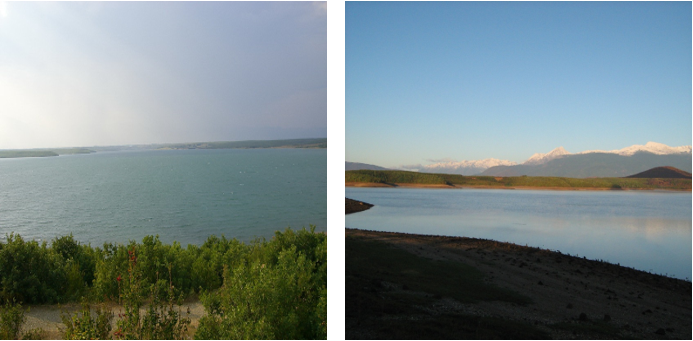
The Krena River separates the villages of Deçan and Gjakova. Due to its geographical position, the river is located in an area surrounded by many inhabited buildings, which has contributed to the pollution of the area (such as the discharge of wastewater, the dumping of garbage by residents, and changes in the water level during different seasons of the year). As a result, due to the limited vegetation, there is a noticeable lack of species diversity.
The river is located in an area surrounded by many inhabited buildings, which has contributed to the pollution of the area (such as the discharge of wastewater, the dumping of garbage by residents, and changes in the water level during different seasons of the year). As a result, due to the limited vegetation, there is a noticeable lack of species diversity.
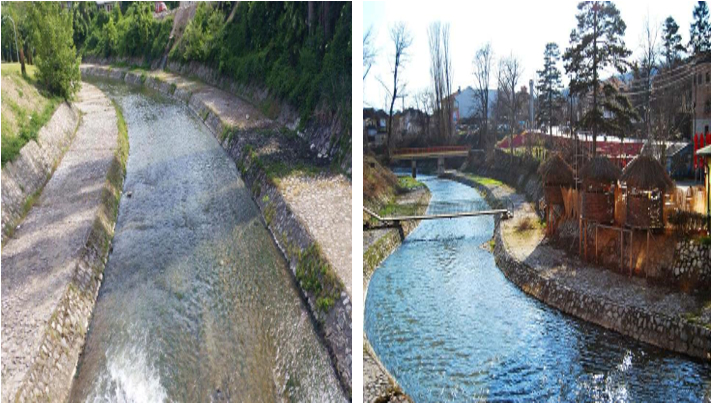
MATERIALS AND METHODS
Collection of Material and Laboratory Processing
To carry out this research, we based our work on faunistic findings.
This location was considered the most suitable for gathering insect samples.
The method used involved a plastic container, a UV lamp, detergent, tweezers, and 70% alcohol, with the setup placed in areas where the river was rich in vegetation and the water quality was considered optimal.
The collection process took place at night, immediately after sunset, using a UV lamp to attract insects.
The lamp was left overnight positioned above a plastic container filled with detergent.
The following morning, the gathered samples were retrieved, and the insects were preserved in containers filled with 70% alcohol and properly sealed.
Insects in the larval stage were collected separately during the daytime, also using plastic containers.
Adult insects were collected on October 1st, 2019, and larval specimens were gathered on October 26th, 2019.
In the laboratory, all specimens were identified using a stereomicroscope based on taxonomic keys (Malicky 2004; Kumanski 1985–1988).
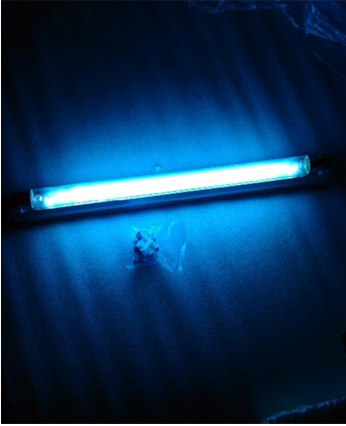
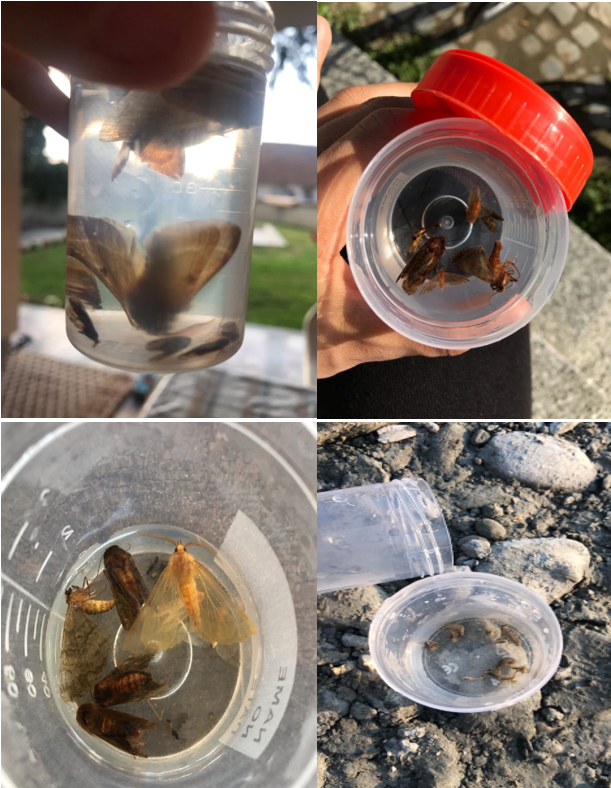
Results of the Research Study
The material collected from the order Trichoptera (adult forms) was identified down to the species level, except for some individuals belonging to the genus Hydropsyche Pictet, 1834 (females). Meanwhile, the larval stage material from the orders Ephemeroptera , Plecoptera , and Trichoptera was identified to the family level.
From the identified material for the order Trichoptera , a total of 120 individuals were recorded, belonging to 5 families and 15 species.
The families identified during this study are Rhyacophilidae , Philopotamidae , Hydropsychidae , Psychomyiidae , and Limnephilidae.
The family with the highest number of species is Psychomyiidae , with the species Psychomyia pusilla and Tinodes pallidulus.
The family Hydropsychidae includes the species Hydropsyche angustipennis , Hydropsyche bulbifera , and Hydropsyche sp. (female specimens).
The family Rhyacophilidae is represented by the species Rhyacophila fasciata , Rhyacophila nubile , Rhyacophila polonica , and Rhyacophila obliterata.
The family Philopotamidae includes the species Wormaldia occipitalis , while the family Limnephilidae is represented by the species Drusus botosananui , Limnephilus vittatus , Limnephilus auricular , Potamophylax rotundipennis , and Potamophylax pallidus .
Systematics of the order Trichoptera
TRICHOPTERA SPECIALPIA
Superfamily : RHYACOPHILOIDEA Stephens, 1836
Family : RHYACOPHILIDAE Stephens, 1836
Genus : Rhyacophila Pictet, 1834
Rhyacophila fasciata Hagen, 1859
Rhyacophila nubila Zetterstedt, 1840
Rhyacophila obliterata McLachlan, 1863
Rhyacophila polonica McLachlan 1879
ANNULIPALPIA
Superfamily : PHILOPOTAMOIDEA Stephens, 1829
Family:PHILOPOTAMIIDAEStephens, 1829
Genus : Wormaldia McLachlan, 1865
Wormaldia occipitalis (Pictet, 1834)
Superfamily : HYDROPSYCHOIDAE Curtis, 1835
Family : HYDROPSYCHIDAE Curtis, 1835
Genus: Hydropsyche Pictet, 1834
Hydropsyche angustipennis Curtis, 1834
Hydropsyche bulbifera McLachlan, 1878
Family : PSYCHOMYIIDAE Walter, 1852
Genus : Psychomyia Latreille, 1829
Psychomyia klapaleki Malicky, 1995
Genus: Tinodes Curtis, 1834
Genus: Tinodes pallidulus McLachlan, 1878
INTEGRIPALPIA
Superfamily : LIMNEPHILOIDAE Kolenati, 1848
Family : LIMNEPHILIDAE: Kolenati, 1848
Genus : Drusus Stephens, 1837
Drusus botosaneanui Kumanski, 1968
Genus : Limnephilus Leach, 1815
Limnephilus auricula Curtis, 1834
Limnephilus vittatus (Fabricius, 1798)
Genus : Potamophylax Wallengren, 1891
Potamophylax pallidus (Lpapalek, 1899)
Potamophylax rotundipennis (Brauen , 1857 )
| Species/date: 28.09.2019 | Number of Individuals |
| Potamophylax rotundipennis | 2 |
| Potamophylax pallidus | 1 |
| Hydropsyche angustipennis | 5 |
| Tinodes pallidulus | 11 |
| Wormaldia occipitalis | 3 |
| Rhyacophila fasciata | 5 |
| Rhyacophila nubila | 1 |
| Rhyacophila polonica | 4 |
| Rhyacophila obliterata | 2 |
Table 1: Composition of the Trichoptera fauna (adult stage) at Locality I – Rripe
| Species/date 29.09.2019 | Number of Individuals |
| Drusus botosaneanui | 1 |
| Potamophylax rotundipennis | 2 |
| Potamophylax pallidus | 4 |
| Hydropsyche angustipennis | 5 |
| Tinodes pallidulus | 11 |
| Wormaldia occipitalis | 13 |
| Rhyacophila fasciata | 2 |
| Rhyacophila nubila | 1 |
| Rhyacophila obliterata | 4 |
| Species/date 30.09.2019 | Number of Individuals |
| Limnephilus vittatus | 1 |
| Limnephilus auricula | 1 |
| Potamophylax rotundipennis | 2 |
| Potamophylax pallidus | 1 |
| Hydropsyche angustipennis | 2 |
| Tinodes pallidulus | 3 |
| Wormaldia occipitalis | 8 |
| Rhyacophila fasciata | 5 |
| Rhyacophila nubila | 1 |
| Rhyacophila polonica | 1 |
| Rhyacophila obliterata | 1 |
Table 3: Radoniq locality. Results of adult specimen collection
| Species/date 01.10.2019 | Number of Individuals |
| Hydropsyche bulbifera | 2 |
| Hydropsyche sp. femra | 12 |
| Psychomyia pusilla | 3 |
| Species/date 26.10.2019 | Number of individuals |
| Rhyacophilidae | 11 |
| Philopotamidae | 4 |
| Sericostomatidae | 1 |
| Perlidae | 4 |
| Perlodidae | 1 |
| Ephemeridae | 4 |
| Baetidae | 13 |
| Leptophlebiidae | 4 |
| Simuliidae | 5 |
| Cordulegastridae | 6 |

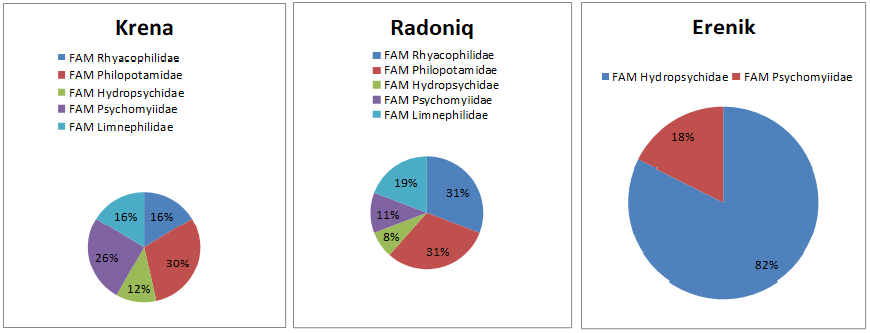
Discussion
The results of this research aim to provide a list of species of the order Trichoptera, along with their distribution along the flow of the Erenik River, Krena, Rripe, and Radoniq Lake. During this study, larvae from the orders Ephemeroptera, Plecoptera, and Trichoptera (EPT) were also collected.
During this research, from the order Trichoptera (adult stage), 15 species were identified, with the number varying depending on the locality. Most of the species found during this research have a wide distribution in Kosovo (Ibrahimi et al., 2012a,b; 2014a,b; 2016). The identified species belong to the families Rhyacophilidae, Philopotamidae, Hydropsychidae, Psychomyiidae, and Limnephilidae.
Family: Rhyacophilidae with the species Rhyacophila fasciata (found in 3 localities), Rhyacophila nubile (found in 3 localities), Rhyacophila polonica (found in 2 localities), and Rhyacophila obliterata (found in 3 localities).
Family: Philopotamidae with the species Wormaldia occipitalis (found in 3 localities).
Family: Hydropsychidae, with the species Hydropsyche angustipennis (found in 3 localities), Hydropsyche bulbifera (found in 1 locality), and Hydropsyche sp. (female) (found in 1 locality).
Family: Psychomyiidae with the species Psychomyia pusilla (found in 1 locality) and Tinodes pallidulus (found in 3 localities).
Family: Limnephilidae, with the species Drusus botosaneanui (found in 1 locality), Limnephilus vittatus (found in 1 locality), Limnephilus auricular (found in 1 locality), Potamophylax rotundipennis (found in 3 localities), and Potamophylax pallidus (found in 3 localities).
Meanwhile, the material from the larval stage (EPT orders) belongs to the families
Family: Rhyacophilidae with 11 individuals,
Family: Philopotamidae, Perlidae, Ephemeridae, Leptophlebidae with 4 individuals,
Family: Philopotamidae with 4 individuals,
Family: Sericostomatidae, Perlodidae with 1 individual,
Family: Baetidae with 13 individuals,
Family: Simuliidae with 5 individuals,
and Family Cordulegasteridae with 6 individuals.
Similar biocenological and ecological studies of macrozoobenthos in Kosovo have been carried out in river ecosystems such as the Lumbardhi of Prizren (Shukriu et al., 1979), the Mirusha River (Gashi et al., 1993), the Sitnica River (Rugova, 2002; Zhushi-Ethemi, 2005), etc.
All previous assessments of freshwater quality in Kosovo show that the anthropogenic impact, resulting from the growth of human settlements and related activities, is increasing and represents the main stressor changing the condition of freshwater macroinvertebrate communities, which are among the most sensitive elements to this pollution.
Conclusions
Based on the results of this study, the following conclusions can be drawn:
➔ This research was conducted in the Rripe, Krena, and Erenik rivers and Radoniq Lake during September–October 2019.
➔ During this research, the faunistic composition of aquatic insects belonging to the orders Ephemeroptera, Plecoptera, and Trichoptera (EPT) was analyzed.
➔ For the order Trichoptera (adult stage), the following were recorded:
➔ 5 Families
➔ 8 Genera
➔ 15 Species
➔ 120 Individuals
➔ The highest number of species belonged to the family Psychomyiidae, while the family Philopotamidae was represented by only one species.
➔ The locality with the highest number of species was Radoniq Lake, while the Erenik River had the lowest number of species.
➔ The main families identified at the larval stage were Rhyacophilidae, Philopotamidae, Sericostomatidae, Perlidae, Perlodidae, Ephemeridae, Baetidae, Leptophlebiidae, and Cordulegastridae.
➔ The data from this study can be used for the biological assessment of water quality in the surveyed localities.
➔ Additionally, the data contribute to the understanding of the Trichoptera fauna in the Erenik River.
References
1. Ibrahimi, H., Kucinic, M., Gashi, A., Grapci-Kotori, L., 2012B: The caddisfly fauna (Insecta, Trichoptera) of the rivers of the Black Sea basin in Kosovo with distributional
data for some rare species. ZooKeys 182: 71-86.
2 Ibrahimi, H., Kucinic, M., Gashi, A., Grapci-Kotori, L., Vuckovic, I. & Cerjanec, D., 2012a: The genus Rhyacophila Pictet, 1834 (Insecta: Trichoptera) in Kosovo. Aquatic Insect. Vol. 34, Supplement 1, 23-31.
3. Ibrahimi, H., Kucinic, M., Gashi, A., & Grapci-Kotori, L., 2014a: Trichoptera Biodiversity of the Aegean and Adriatic Sea Basins in the Republic of Kosovo. J. Insect Sci. 14(209): 2014, DOI: 10.1093/jisesa/ieu071
4. Ibrahimi, H., 2011; Faunisticke, ekoloske i Ibrahimi, H., 2011: Faunisticke, ekoloske i biogeografske znacajke Tulara (Insecta: Trichoptera) Kosova. Doktorska disertacija, Sveuciliste u Zagrebu, Sveuciliste u Zagrebu, 1-193.
5. Ibrahimi, H., Gashi, A., Bilalli, A., Musliu, M., Grapci Kotori, L., & Zhushi Etemi, F., 2014B: Three new country records from the genus Limnephilus Leach, 1815 (Trichoptera: Limnephilidae) from the Republic of Kosovo. Biodiversity Data Journal 2:e4140.
6. Ibrahimi, H., Gashi, A., Grapci Kotori, L., Zhushi Etemi, F., Bilalli, A. & Musliu, M., 2015a: New Distribution and Species Records of Caddisflies (Insecta Trichoptera) from the Republic of Kosovo. Entomological News, 125(4): 229-238.
7. Ibrahimi, H., Gashi, A., Qela, E., Haxhiaj, R., Bilalli, A. & Musliu, M., 2016a: New records for some rare caddisfly species from Kosovo (Trichoptera). SPIXIANA 39 1 98 Munchen.
8. Bilalli, A. 2019: Veçoritë ekologjike, taksonomike dhe biogjeografike të insekteve ujore të Bjeshkëve të Karadakut. Punim i doktoratës. Universiteti i Prishtinës, FSHMN. 1-205.
9. Kumanski, K. P., 1985: Trichoptera, Annulipalpia. Fauna Bulgarica 15, Sofia: Bulgarska Akademi na Naukite, 243 str.
10. Kumanski, K. P., 1988: Trichoptera, Integripalpia. Fauna Bulgarica 19, Sofia: BulgarskaAkademi na Naukite, 354 str.
11. Malicky, H., 2004: Atlas of European Trichoptera. 2nd Edition. Springer, Netherlands. 359 pp.
12. Malicky, H., 2005: Die Kocherfliegen Griechenlands. Denisia 17, 1-240.
13. Gashi, A., 1993: Prostorna i sezonska distribucija makrozoobentosa u rijeci Miruši, magistarski rad, Prirodoslovno Matematički Fakultet Sveučilišta u Zagrebu, 1-110.
14. Rugova, E. 2002: Fauna bentale si indikator i kualitetit të ujit në rrjedhën e mesme të lumit Sitnicë. Universitetin e Prishtinës, Punim i Magjistraturës.
15. Shukriu, A., 1976: Distribucija i dinamika populacija rakušaca Amphipoda uslivu Bjelog Drima Magistraski Rad, Sveučilište u Zagrebu.
16. Zhushi-Etemi, F., 2005: Valorizimi biologjik i ujërave të lumit Sitnicë në bazë të përbërjes së faunës bentale. Disertacion i doktoratës, FSHMN, Prishtinë, 1-120.
Sources from the Internet
http://tolweb.org/Trhichoptera/8230
www.nps.gov/sitk/learn/nature/stream-ecology-the-aquatic-insects.htm
www.ammk-rks.net/respository/docs/biodiversiteti_dhe_rendesia_e_tij.pdf
www.sciencedirect.com/topics/agricultural-and-biological-sciences/trichoptera
Disclaimer:
The data and analysis presented in this article are part of an academic research project and are intended solely for informational and educational purposes, some sources cited may no longer be accessible online due to website changes or removals.